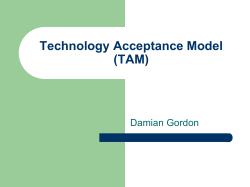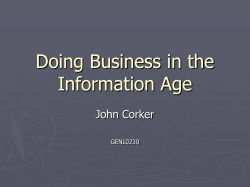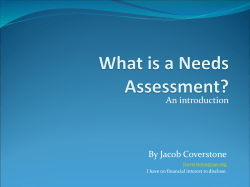
SYSTEM ACCEPTANCE ROLE IN ACTUAL USE OF KNOWLEDGE MANAGEMENT SYSTEMS
Arabian Journal of Business and Management Review (OMAN Chapter) Vol. 4, No.3; October. 2014 SYSTEM ACCEPTANCE ROLE IN ACTUAL USE OF KNOWLEDGE MANAGEMENT SYSTEMS Nasrin Budaghi Department of Management, Germi Branch, Islamic Azad Unversity, Germi, Iran Mohammad Feizi1 Department of Management, Meshginshahr Branch, Islamic Azad Unversity, Meshginshahr, Iran Abstract This study has done to the examining the system acceptance role in actual use of knowledge management systems. The population of the study were both public and private active banks employees in Meshginshahr city that use knowledge management system. According to Cochran sampling, the sample size of this research was set at 175 that selected stratified sampling method. To gathering of data, we used a questionnaire. All the reliability and validity of measures has examined. Questionnaires reliability was estimated by calculating Cronbach’s Alpha; it was 0.789. In order to analyze the data resulted from collected questionnaires descriptive statistical methods are used, and to display some statistical data we used column diagram. Findings show that the mean of all variables were bigger than 3 and so we can say that system acceptance and it dimensions (management support, evaluation system, perceived relevance, and available) have important role in actual use of knowledge management systems at both public and private active banks employees in Meshginshahr. Key words: Knowledge management, management support, evaluation system, perceived relevance, and availability, acceptance system INTRODUCTION Knowledge management efforts typically focus on organizational objectives such as improved performance, competitive advantage, innovation, the sharing of lessons learned, integration and continuous improvement of the organization (Gupta and Sharma, 2004). KM efforts overlap with organizational learning and may be distinguished from that by a greater focus on the management of knowledge as a strategic asset and a focus on encouraging the sharing of knowledge (Maier, 2007). It is seen as an enabler of organizational learning and a more concrete mechanism than the previous abstract research (Sanchez, 1996) Previous knowledge management approaches focus on business aspects rather than education (Alavi and Leidner, 2001). Innovative approaches for turning knowledge management into practical teaching activities have been ignored. Many organizations pursue knowledge management (KM) initiatives, with different degrees of success. One key aspect of KM often neglected in practice is that it not only concerns technology. Technology merely provides the tools with which employees can leverage their knowledge in the context of their work. Thus, 1 Correspondence author 14 Arabian Journal of Business and Management Review (OMAN Chapter) Vol. 4, No.3; October. 2014 how employees perceive the technology and interact with it is assumed to play a major role in KM initiatives' success (Bals et al, 2007). Early KM technologies included online corporate yellow pages as expertise locators and document management systems. Combined with the early development of collaborative technologies (in particular Lotus Notes), KM technologies expanded in the mid-1990s. (Alavi and Leidner, 1999). Subsequent KM efforts leveraged semantic technologies for search and retrieval and the development of e-learning tools for communities of practice (Capozzi 2007).Knowledge management systems can thus be categorized as falling into one or more of the following groups: Groupware, document management systems, expert systems, semantic networks, relational and object oriented databases, simulation tools, and artificial intelligence (Gupta and Sharma, 2004). More recently, development of social computing tools (such as bookmarks, blogs, and wikis) have allowed more unstructured, self-governing or ecosystem approaches to the transfer, capture and creation of knowledge, including the development of new forms of communities, networks, or matrixed organisations (Calvin, 2005). However such tools for the most part are still based on text and code, and thus represent explicit knowledge transfer (McAdam and McCreedy, 2000). These tools face challenges in distilling meaningful re-usable knowledge and ensuring that their content is transmissible through diverse channels (Gene, 2013). The basic concept behind user acceptance frameworks is that user perceptions about information technology influence their intention to use and ultimately their actual use of information technology. In addition, the actual use of an information technology system has a feedback relationship with user perceptions. Technology Acceptance Models (TAM) have typically been used to explain why technology is or is not successful by studying the antecedents “perceived usefulness” and “perceived ease of use” and their impact on intention to use technology (Davis, 1989). Empirical studies of TAM have consistently found that perceived usefulness is a strong determinant of intention to use (Venkatesh & Davis, 2000). Research has also found that perceived usefulness is a predictor of attitudes toward using technology both before implementation and in the post-implementation environment (Meg Fryling, 2012). This model emphasizes surveying individual attitudes toward information technology, and has been widely employed in many significant studies of user attitudes (Liaw & Huang, 2003; Liaw, Huang & Chen, 2007). The understanding of learners' attitudes can help effectively expand system functions and meet learners' needs. METHODOLOGY The main purpose of the present research is evaluating the system acceptance to actual use knowledge management systems. The research method is descriptive. We examine the employees acceptance system to actual use of knowledge management systems according to four dimensions; management support, evaluation system, perceived relevance, and availability. The population of the study were both public and private active banks employees in Meshginshahr city that use knowledge management system. According to Cochran sampling, the sample size of this research was set at 175 that selected stratified sampling method. To gathering of data, we used a questionnaire. All the reliability and validity of measures has examined. Questionnaires reliability was estimated by calculating Cronbach’s Alpha; it was 0.789. 15 Arabian Journal of Business and Management Review (OMAN Chapter) Vol. 4, No.3; October. 2014 In order to analyze the data resulted from collected questionnaires descriptive statistical methods are used, and to display some statistical data we used column diagram. The analysis has performed with SPSS. RESULTS AND CONCLUSION The demographic data gathered from questionnaire shows that eighty Seven percent of the responders are male and thirteen percent of the responders are female. The responder’s degree is 14.9 percent MA, 59.4 percent Bachelor, 24 percent Diploma and 1.7 percent have No degree. It means that the most of the responder have university degree. Table1- Responders Gender and Degree Valid Frequency Percent Gender Degree Male Female Total 153 22 87.4 12.6 175 100.0 No degree Diploma Bachelor/Profession al Master Total 3 42 1.7 24.0 104 59.4 26 175 14.9 100.0 Table 2 shows age of the responders. 1.1 percent of responders have under 30 years’ old, and 37.7 percent have between 30-40, 34.3 percent 40-50, and finally 26.9 percent have more than 51 years of work experience. It shows that most the personnel age are between 30- 50. Table 2- Age of the responders Valid Frequency Percent Below 30 years old 2 1.1 Between 30 and 40 66 37.7 Between 41 and 50 60 34.3 Above 51 years old 47 26.9 Total 175 100.0 From the precedence point of view about 9.7 percent of responders were Less than 5 years. 9.1 percent between 5-10, 24.6 percent have between 10 - 15, 37.7 percent have between 15 - 20, and finally 18.9 percent have experience more than 21 years. It shows that all the managers have good experience. Table 3- experience of the responders Frequency Percent Valid 17 9.7 5 to 10 16 9.1 10 to 15 43 24.6 15 to 20 66 37.7 Above 20 Years 33 18.9 Total 175 100.0 16 Arabian Journal of Business and Management Review (OMAN Chapter) Vol. 4, No.3; October. 2014 We examine the employees trust to actual use of knowledge management systems according to three dimensions management support, evaluation system, perceived relevance, and available. The following table shows the Frequency distribution (Mean and standard deviation) of system acceptance to actual use of knowledge management systems. The acceptance system to actual use of knowledge management systems calculated by management support, evaluation system, perceived relevance, and available indexes. Table 4: Mean and standard deviation of Management support and its dimensions Variable Management Use from System System as an integral part of career Provide adequate resources by organizations Training programs offered at organization Total Management support Mean 3.97 3.74 4.37 4.05 4.03 SD .979 .835 .892 .804 .775 Graph 1: Mean of Management support dimensions Training programs offered at organization 4.05 Provide adequate resources by organizations 4.37 3.74 System as an integral part of career 3.97 Management Use from System 3.4 3.5 3.6 3.7 3.8 3.9 4 4.1 4.2 4.3 4.4 4.5 According to table 4 and Graph 1 Management Use from System has 3.97 mean, System as an integral part of career has 3.74, Provide adequate resources by organizations has 4.37 mean, and Training programs offered at organization has 4.05 mean. Total Management support has 4.03 mean and it means that Management support have an important role in actual use of knowledge management systems. Table 5 : Mean and standard deviation of Evaluation system and its dimensions Variable Mechanisms exist to verify the contents entered into the system Reward systems based on the level of participation in the system Total Evaluation system Graph 2: Mean of Evaluation system dimensions 17 Mean 4.30 SD .784 4.38 .770 4.34 . 643 Arabian Journal of Business and Management Review (OMAN Chapter) Vol. 4, No.3; October. 2014 Reward systems based on the level of participation in the system 4.38 Mechanisms exist to verify the contents entered into the system 4.3 4.26 4.28 4.3 4.32 4.34 4.36 4.38 4.4 According to table 5 and Graph 2 Mechanisms exist to verify the contents entered into the system has 4.30 mean and Reward systems based on the level of participation in the system has 4.38. Total Evaluation system has 4.34 mean and it means that Evaluation system have an important role in actual use of knowledge management systems. Table 6: Mean and standard deviation of Perceived relevance and its dimensions Variable System role in accomplishing tasks quickly System role in improving employee performance System role in the ease of doing work by user System role in enhancing control over user job total Perceived relevance Mean 3.65 3.39 4.07 3.78 3.72 SD 1.155 .908 1.189 1.005 .983 Graph 3: Mean of Perceived relevance dimensions System role in enhancing control over user job 3.78 System role in the ease of doing work by user 4.07 System role in improving employee performance 3.39 System role in accomplishing tasks quickly 3.65 0 1 2 3 4 5 According to table 6 and Graph 3, System role in accomplishing tasks quickly has 3.65 mean, System role in improving employee performance has 3.39, System role in enhancing control over user job has 3.73 mean, and System role in the ease of doing work by user has 4.07 mean. Total Perceived relevance has 3.72 mean and it means that Perceived relevance have an important role in actual use of knowledge management systems. Table 7: Mean and standard deviation of Availability and its dimensions Variable Take advantage of easy system Understanding of the system 18 Mean 4.49 4.49 SD .787 .772 Arabian Journal of Business and Management Review (OMAN Chapter) Flexibility in interacting systems Total Availability Vol. 4, No.3; October. 2014 3.35 4.11 1.422 .630 Graph 4: Mean of Availability dimensions 3.35 Flexibility in interacting systems Understanding of the system 4.49 Take advantage of easy system 4.49 0 1 2 3 4 5 According to table 7 and Graph 4 Take advantage of easy system has 4.49 mean, Understanding of the system has 4.49, and Flexibility in interacting systems has 3.35 mean. Total Availability has 4.11 mean and it means that Availability have an important role in actual use of knowledge management systems. Findings show that the mean of all variables were bigger than 3 and so we can say that system acceptance and it dimensions (management support, evaluation system, perceived relevance, and available) have important role in actual use of knowledge management systems at both public and private active banks employees in Meshginshahr. References 1. Alavi, M., Leidner, D,E. (2001). Knowledge management and knowledge management systems: conceptual foundations and research issues. MIS Quarterly, 25 (1), 107-136. 2. Alavi, M., Leidner, D,E. (1999). "Knowledge management systems: issues, challenges, and benefits". Communications of the AIS 1 (2). 3. Bals, C. ; Smolnik, Stefan ; Riempp, G. (2007), Assessing User Acceptance of a Knowledge Management System in a Global Bank: Process Analysis and Concept Development, System Sciences, 2007. HICSS 2007. 40th Annual Hawaii International Conference on 4. Bellinger G.,. "Mental Model Musings". Systems Thinking Blog. Retrieved 18 April 2013. 5. Calvin, D. Andrus (2005). "The Wiki and the Blog: Toward a Complex Adaptive Intelligence Community". Studies in Intelligence 49 (3) 6. Capozzi, Marla M. (2007). "Knowledge Management Architectures Beyond Technology". First Monday 12 (6). 7. Davis, F. D. (1989). Perceived usefulness, Perceived Ease of use, and User Acceptance of Information Technology. MIS Quarterly, 13 (3), 319-340. 8. Gupta J., Sharma S., (2004). Creating Knowledge Based Organizations. Boston: Idea Group Publishing 9. Liaw, S.-S, Huang, H.-M., & Chen, G.-D. (2007). Surveying instructor and learner attitudes toward e-learning, Computers & Education, 49, 1066-1080. 19 Arabian Journal of Business and Management Review (OMAN Chapter) Vol. 4, No.3; October. 2014 10. Liaw, S.-S., & Huang, H.-M. (2003). An Investigation of User Attitudes Toward Search Engines as an Information Retrieval Tool, Computer in Human Behavior, 19, 751-765. 11. Maier, R. (2007). Knowledge Management Systems: Information And Communication Technologies for Knowledge Management (3rd edition). Berlin: Springer. 12. McAdam, R.,; McCreedy, S., (2000). "A Critique Of Knowledge Management: Using A Social Constructionist Model". New Technology, Work and Employment 15 (2) 13. Meg Fryling, (2012), Incorporating Technology Acceptance and IS Success Frameworks into a System Dynamics Conceptual Model: A Case Study in the ERP PostImplementation Environment, International Journal of Information Technologies and Systems Approach, 5(2), 41-56. 14. Sanchez, R. (1996). Strategic Learning and Knowledge Management. Chichester: Wiley. 15. Vankatesh, V., & David, F. D. (2000). A theoretical extension of the technology acceptance model: Four longitudinal field studies. Management Science, 46 (2), 186 20
© Copyright 2025
















